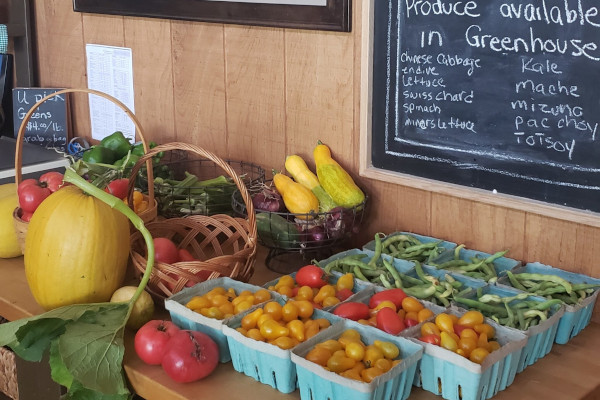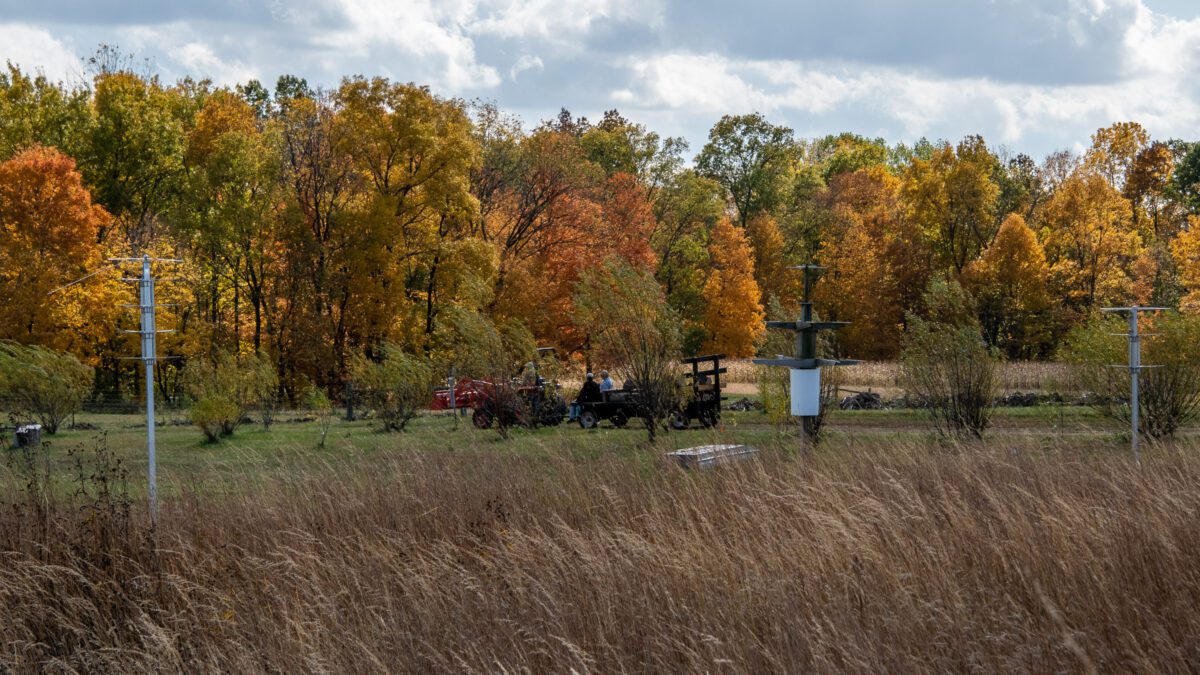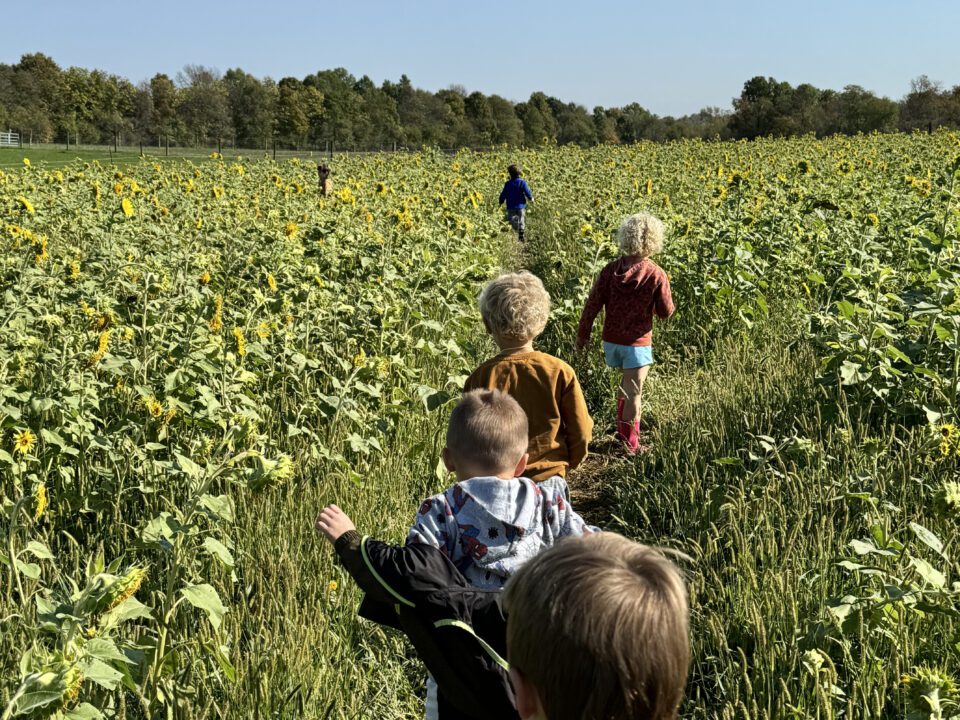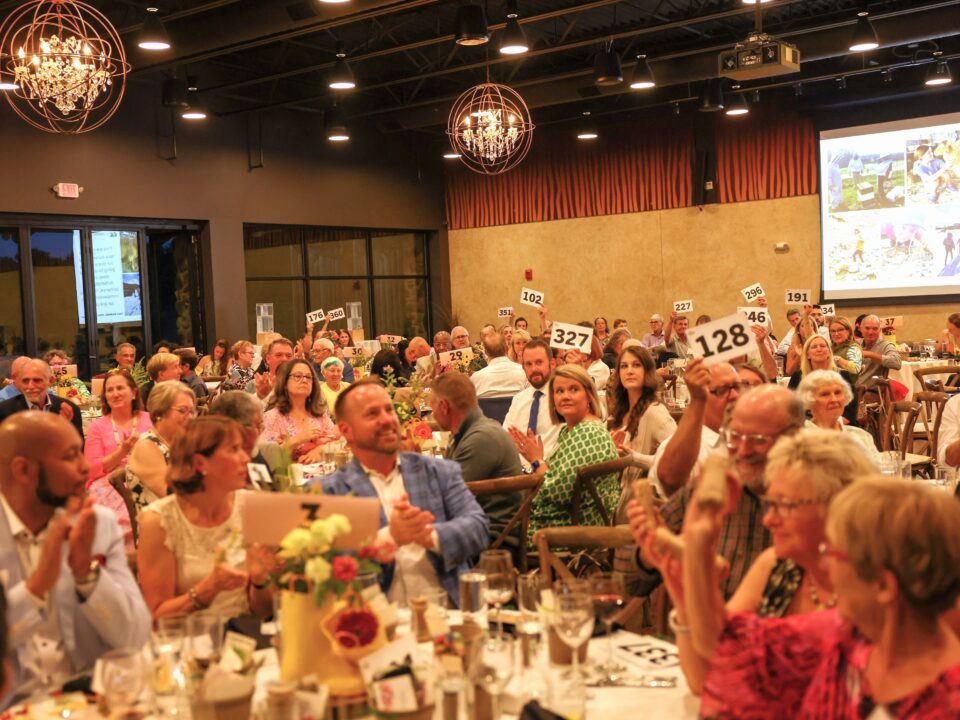
Watermelon is a Smart Remedy to Revive Hot Hay Makers
September 15, 2018
Tour Season Ends at Stratford with a Scrumptious Potluck
November 17, 2018This article was first published in The Delaware Gazette on October 20, 2018
Fall has been a fun time at Stratford Ecological Center on Liberty Road. Having fun is the most important element in our efforts to connect our busloads of young school children to the land.
A great way to start a tour, and extinguish any fears or expend any pent-up energy, is to run out to the field and climb on our caterpillar made of round hay bales end to end, with corn stalks for antennas and sunflowers for eyes. The youngsters hoist themselves up the bales, and crawl, walk or slide down until they spy the sunflower maze next door.
They rush in, call out to each other when they reach a dead end, reverse course until they finally come out. Then there is an opportunity to settle down and look at a sunflower head and discover the seeds that they eat as a snack at home. It is easy to go on and talk about apple seeds and sweet corn kernels, and that their food and animal feed is produced on a farm.
The chickens love sunflowers, so the children find the perfect head and set off to feed them from outside the fence. By turning the sunflower upside down and poking the stalk through the wire to secure it, they can observe the chickens picking off the seeds before joining them in the pen. It still comes as a surprise how many children are willing to feed by hand and hold a chicken, even though they may never have encountered one. After that experience the stage is set to explore the barn, fields and woods and see what is happening on the farm.
This month has been a busy one with the animals. Sassy, the Jersey cow, has regained much of her weight loss due to calves suckling on her, and has been released from the barn. She is now alone in the corral and in another couple weeks her milk should dry off completely and she can return to the herd. After Christmas Farmer Jeff plans to bring in a black Angus bull on loan from Ron Hastings, a farmer in Ashville to run with the herd. We can expect calves this time next year.
Farmer Jeff was pleased with the growth of Jersey cow Pumpkin’s eighteen-month-old big-horned steer and decided to market him at 1,000 lbs. Cattle tend to lose weight over winter and put it back on in the spring. He hoped to avoid this, and save on winter feed, by marketing at a lower weight and age than normal for us.
He drove the steer in the horse trailer to a new processing facility only to find they were not equipped with the proper fencing to unload a big animal from such a trailer, and much to his disappointment had to bring him home. Meat processors are becoming few and far between for small orders these days, and unless we can find another who has an opening we will have to keep the steer and make an appointment for next spring.
We were able to take Donna, our sow, who regrettably has become infertile, to another processor. She was looking fit and behaved so well during loading and unloading. It is always hard to say goodbye. She weighed in at 534 lbs.
Two cull ewes and three spring lambs left the same day. The remaining twenty-one sheep, including six spring lambs, will be bred this month using “Dodge,” the same ram we borrowed from Delaware Preservation Park’s Galant Farms last fall. Rusty our other ram will not be used this year; he will breed at another farm.
Winter spelt has been planted in the south half of field 2, and the west half of field 5. Once the tomato plants are removed from field 3 an acre of spelt will be seeded, alongside the annual planting of garlic.
The corn moisture should be around fifteen percent this weekend, and therefore will be ready for harvest. We would like to cut and bale the green Sorghum Sudan grass surrounding the corn to feed during the coming month. However, we have a predicament. Frost has been predicted and Sorghum becomes toxic after a killing frost, but we cannot bale it until the corn is ready as the grass acts as a barrier between invading deer and the corn.
The Fall Festival, Hands on the Land (a program for 4th grade Delaware City school children,) Friends Reception, and Fall Campfire are all behind us. Rain dampened the campfire but not the spirit or the appetite, and a new eleven-year-old volunteer was a most welcome asset as she lit the cooking fires, helped supervise the roasting of hotdogs and marshmallows, and stayed to wash up. Fall colors are becoming evident, and it’s a perfect time to take a walk in the fields and the woods. You may even spy the red fox who was observed eyeing us in the pasture between the pond and the sugar shack.
Pauline Scott is a farm and nature guide at Stratford Ecological Center.





